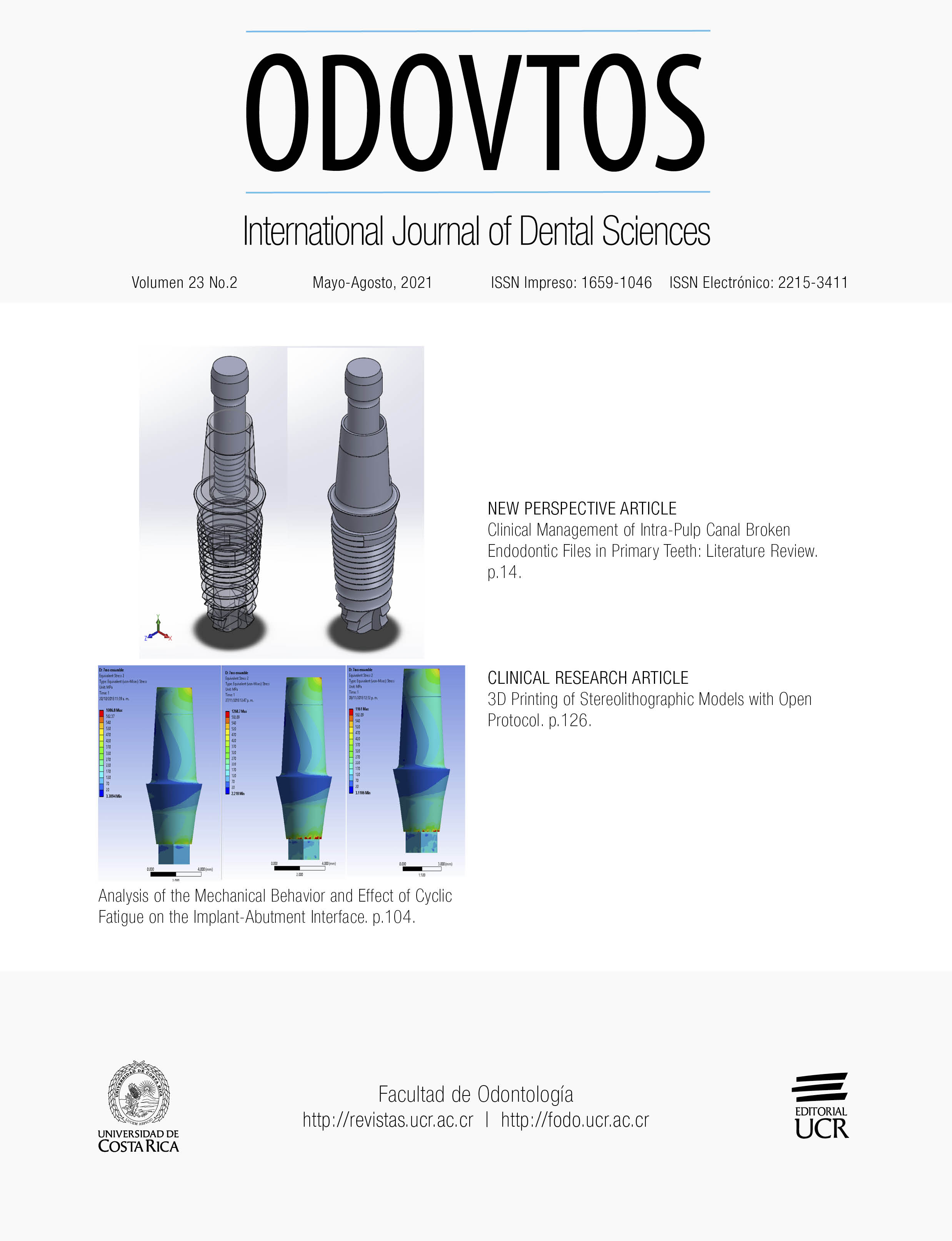Abstract
The aim of this study was to evaluate the prevalence and distribution of pulp stones in a group of Peruvian adults using cone beam tomography (CBCT). Materials and methods: 60 randomly selected CBCT from a tomographic center in Lima, Peru were analyzed. A total of 1263 images of teeth using the Point 3D Combi 500 S tomograph were evaluated. Images analysis was performed with Real Scan software and all teeth were evaluated in sagittal, axial and coronal views. All measurements were subjected to a chi square test. (p<0.05). Results: Of the 1263 teeth, 30.8% presented pulp calcifications through the CBCT. The prevalence of calcifications was higher in women than in men. The maxillary and mandibular molars were the groups of teeth with the highest frequency of pulp stones. There was significance between the pulp stones and the gender, age range, type and state of the tooth. Conclusions: The maxillary first molars had a higher prevalence of pulp calcifications than the mandibular ones. The presence of caries increased the possibility of the appearance of these calcifications, specifically in the maxillary teeth. CBCT could be a sensitive tool to detect pulp stones. Knowledge of the distribution of pulp stones can help dentists in the clinical treatment of endodontics.
References
Kuttler Y. Classification of dentine into primary, secondary and tertiary. Oral Surg Oral Med Oral Pathol 1959; 12: 996-9.
Nait Lechguer A., Couble M.L., Labert N., et al. Cell differentiation and matrix organization in engineered teeth. J Dent Res 2011; 90: 583-9.
Sener S., Cobankara F.K., Akgünlü F. Calcifications of the pulp chamber: prevalence and implicated factors. Clin Oral Investig. 2009; 13 (2): 209-15.
Bevelander G., Johnson P.L. Histogenesis and histochemistry of pulpal calcification. J Dent Res. 1956; 35 (5): 714-22.
Goga R., Chandler N.P., Oginni A. Pulp stones: a review. Int Endod J. 2008; 41 (6): 457-68.
Kannan S., Kannepady S.K., Muthu K., Jeevan M.B., Thapasum. A Radiographic assessment of the prevalence of pulp stones in Malaysians. J Endod. 2015; 41 (3): 333-7.
Rodrigues V.S.I., Schacht J., Bortolotto M., Manhaes J., Tomazinho L.F., Boschini S. Prevalence of pulp stones in cone beam computed tomography. Dent Press Endod. 2014; 4 (1): 57-62.
Hsieh C., Wu Y., Su C., Chung M., Huang R., Ting P. et al. The prevalence and distribution of radiopaque, calcified pulp stones: A cone-beam computed tomography study in a northern Taiwanese population. JDS. 2018; 13 (2): 138-44.
Sundell J.R., Stanley H.R., White C.L. The relationship of coronal pulp stone formation to experimental operative procedures. Oral Surg Oral Med Oral Pathol.1968; 25 (4): 579-89.
Movahhedian N., Haghnegahdar A., Owji F. How the prevalence of pulp Stone in a population predicts the risk for kidney stone. Iran Endod J. 2018; 13 (2): 246-50.
Patil S.R., Sinha N. Pulp stone, haemodialysis, end‑stage renal disease, carotid atherosclerosis. J Clin Diagn Res. 2013; 7 (6): 1228‑31.
Sayegh F.S., Reed A.J. Calcification in the dental pulp. Oral Surg Oral Med Oral Pathol.1968; 25 (6): 873-82.
Huang, L., Chen, G. A histological and radiographic study of pulpal calcification in periodontally involved teeth in a Taiwanese population. JDS. 2016; 11 (4): 405-10.
Moss, L., Hendricks, M. Calcified Structures in Human Dental Pulps. J Endod. 1988; 14 (4): 184-9.
Sandeepa N.C., Ajmal M., Deepika N. A retrospective panoramic radiographic study on prevalence of pulp stones in South Karnataka population. World J Dent. 2016; 7 (1): 14‑7.
Tassoker T., Magat G., Sener S., Jeevan M.B., Thapasum A. A comparative study of cone-beam computed tomography and digital panoramic radiography for detecting pulp stones. Imaging Sci Dent. 2018; 48 (3): 201-12.
Rosen E., Taschieri S., Del Fabbro M., Beitlitum I., Tsesis I. The diagnostic efficacy of cone-beam computed tomography in endodontics: a systematic review and analysis by a hierarchical model of efficacy. J Endod. 2015; 41 (7): 1008-14.
Patel S., Durack C., Abella F., Shemesh H., Roig M., Lemberg K. Cone beam computed tomography in endodontics - a review. Int Endod J 2015; 48 (1): 3-15.
Rodríguez G., Abella F., Durán-Sindreu F., Patel S., Roig M. Influence of Cone-beam Computed Tomography in Clinical Decision Making among Specialists. J Endod. 2017; 43 (2): 194-9.
Da Silva E.J., Prado M.C., Queiroz P.M., Nejaim Y., Brasil D.M., Groppo F.C., et al. Assessing pulp stones by cone-beam computed tomography. Clin Oral Invest. 2016; 21(7):2327-33.
Patil S.R., Ghani H.A., Almuhaiza M., Al-Zoubi I.A., Anil K.N., Misra N., et al. Prevalence of pulp stones in a Saudi Arabian subpopulation: A cone-beam computed tomography study. Saudi Endod J. 2018; 8 (2): 93-8.
Carvalho T.S., Lussi A. Age-related morphological, histological and functional changes in teeth. J Oral Rehabil. 2017; 44 (4): 291-298.
Verma K., Juneja S., Randhawa S., Dhebar T., Raheja A. Retrieval of Iatrogenically Pushed Pulp Stone From Middle Third of Root Canal in Permanent Maxillary Central Incisor: A Case Report. J Clin Diagn Res. 2015; 9 (6): ZD06-ZD7.
Jannati R., Afshari M., Moosazadeh M., Allahgholipour S., Eidy M., Hajihoseini M. Prevalence of pulp stones: a systematic review and meta-analysis. J Evid Based Med. 2019; 12 (2): 133-139.
Ball R., Barbizam J., Cohenca N. Intraoperative endodontic applications of cone-beam computed tomography. J Endod. 2013; 39 (4): 548-57.
Patel S., Brown J., Pimentel T., Kelly R., Abella F., Durack C. Cone beam computed tomography in Endodontics - a review of the literature. Int Endod J. 2019; 52 (8): 1138-52.
Al-Hadi Hamasha A., Darwazeh A. Prevalence of pulp stones in Jordanian adults. Oral Surg Oral Med Oral Pathol Oral Radiol Endod. 1998; 86 (6): 730-32.
Scarfe W.C., Levin M.D., Gane D., Farman AG. Use of cone beam computed tomography in endodontics. Int J Dent 2009: 1-20.
Tassoker M. Evaluation of the relationship between sleep bruxism and pulpal calcifications in young women: A clinico-radiological study. Imaging Sci Dent. 2018; 48 (4): 277-81.
Satheeshkumar P., Mohan M., Saji S., Sadanandan S., George G. Idiopathic dental pulp calcifications in a tertiary care setting in South India. J Conserv Dent. 2013; 16 (1): 50-5.

